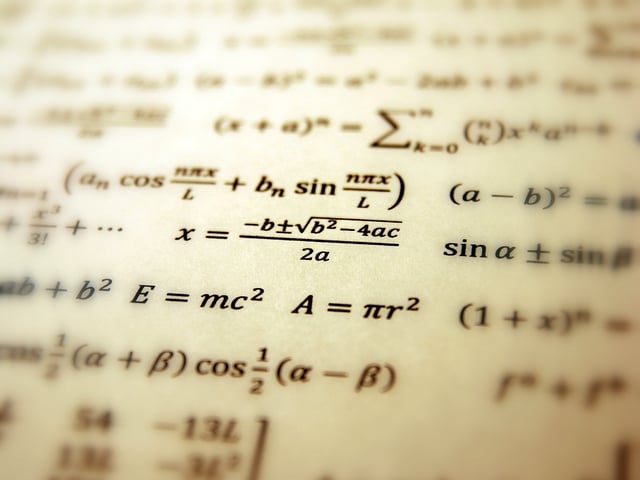
Formulas You’ll Need for the GED Mathematical Reasoning Test
Are you preparing for the GED Mathematical Reasoning Test? We have some good news for you! First of all, you will be able to use a calculator during the test, and second, you’ll have a formula chart given to you, so you won’t have to memorize anything!
But you know, with great power comes great responsibility, so having these two powerful tools at your disposal won’t be enough. You’ll need to practice using them, so you can solve all the questions possible in 115 minutes. That’s why we have prepared this formula chart with exactly the same formulas you’ll have when taking the GED Mathematical Reasoning Test. Start practicing now with the mathematical reasoning practice test we have for you at Union Test Prep!
Mathematical Reasoning Formulas for the GED Test
Area
\[\begin{array}{|c|c|c|} \hline \textbf{Category} & \textbf{Formula} & \textbf{Symbols} \\ \hline \text{Area} & A = s^2 & A = \text{Area of a square} \\ & & s = \text{side length} \\ \hline & & A = \text{Area of a rectangle} \\ \text{Area} & A = l\cdot w & l = \text{length}\\ & & w = \text{width} \\ \hline & & A = \text{Area of a parallelogram} \\ \text{Area} & A = b \cdot h & b = \text{base} \\ & & h =\text{height} \\ \hline & & A = \text{Area of a triangle} \\ \text{Area} & A = \frac{1}{2} \cdot b \cdot h & b = \text{base} \\ & & h = \text{height} \\ \hline & & A = \text{Area of a trapezoid} \\ \text{Area} & A = h \cdot \frac{b_1 + b_2}{2} & b_n = \text{base} \\ & & h = \text{height} \\ \hline & & A = \text{Area of a circle} \\ \text{Area} & A = \pi r^2 & r = \text{radius}\\ & & \pi \approx 3.14 \\ \hline \end{array}\]Perimeter
\[\begin{array}{|c|c|c|} \hline \textbf{Category} & \textbf{Formula} & \textbf{Symbols} \\ \hline \text{Perimeter} & P = 4s & P= \text{Perimeter of a square} \\ & & s = \text{side length} \\ \hline & & P = \text{Perimeter of a rectangle} \\ \text{Perimeter} & P = 2l + 2w & l = \text{length} \\ & & w = \text{width}\\ \hline \text{Perimeter} & P = s_1 + s_2 + s_3 & P = \text{Perimeter of a triangle} \\ & & s_n = \text{side length} \\ \hline & & C = \text{Perimeter of a circle} \\ \text{Perimeter} & C = 2 \pi r = \pi d & r = \text{radius} \\ & & d = \text{diameter} \\ & & \pi \approx 3.14 \\ \hline \end{array}\]Surface Area
\[\begin{array}{|c|c|c|} \hline \textbf{Category} & \textbf{Formula} & \textbf{Symbols} \\ \hline & & SA = \text{Surface Area of rectangular prism} \\ \text{Surface Area} & SA = 2lw + 2lh + 2wh & l = \text{length} \\ & & w = \text{width} \\ & & h = \text{height} \\ \hline & & SA = \text{Surface Area of right prism} \\ \text{Surface Area} & SA = ph + 2B & p = \text{perimeter of base} \\ & & B = \text{area of base} \\ & & h = \text{height} \\ \hline & & SA = \text{Surface Area of cylinder} \\ \text{Surface Area} & SA = 2 \pi rh + 2 \pi r^2 & r = \text{radius} \\ & & h = \text{height} \\ & & \pi \approx 3.14 \\ \hline & & SA = \text{Surface Area of pyramid} \\ \text{Surface Area} & SA = \frac{1}{2} ps + B & p = \text{perimeter of base} \\ & & s = \text{side length} \\ & & B = \text{area of base} \\ \hline & & SA = \text{Surface Area of cone} \\ \text{Surface Area} & SA = \pi rh + \pi r^2 & r =\text{radius} \\ & & h = \text{height} \\ & & \pi \approx 3.14 \\ \hline & & SA = \text{Surface Area of sphere} \\ \text{Surface Area} & SA = 4 \pi r ^ 2 & r = \text{radius} \\ & & \pi \approx 3.14 \\ \hline \end{array}\]Volume
\[\begin{array}{|c|c|c|} \hline \textbf{Category} & \textbf{Formula} & \textbf{Symbols} \\ \hline & & V = \text{Volume of rectangular prism} \\ \text{Volume} & V = lwh & l = \text{length} \\ & & w = \text{width} \\ & & h = \text{height} \\ \hline & & V = \text{Volume of right prism} \\ \text{Volume} & V = Bh & B = \text{area of the base} \\ & & h = \text{height} \\ \hline & & V = \text{Volume of cylinder} \\ \text{Volume} & V = \pi r^2 h & r = \text{radius} \\ & & h = \text{height} \\ & & \pi \approx 3.14 \\ \hline & & V = \text{Volume of pyramid} \\ \text{Volume} & V = \frac{1}{3} Bh & B = \text{area of the base} \\ & & h = \text{height} \\ \hline & & V = \text{Volume of cone} \\ \text{Volume} & V = \frac{1}{3} \pi r^2 h & r = \text{radius}\\ & & h = \text{height} \\ & & \pi \approx 3.14 \\ \hline & & V = \text{Volume of sphere} \\ \text{Volume} & V = \frac{4}{3} \pi r^3 & r = \text{radius} \\ & & \pi \approx 3.14 \\ \hline \end{array}\]Statistics
\[\begin{array}{|c|c|c|} \hline \textbf{Category} & \textbf{Formula} & \textbf{Symbols} \\ \hline & & \bar{x} = \text{mean} \\ \text{Statistics} & \bar{x} = \frac{\sum{x_i}}{n} & x_i = \text{value of each measurement} \\ & & n = \text{number of measurements}\\ \hline \text{Statistics} & Md = (\frac{n+1}{2}) ^{th} \text{ term} & Md = \text{Median} \\ & & n = \text{number of measurements (odd)} \\ \hline \text{Statistics} & Md = \dfrac{(\frac{n}{2})^{th} \text{ term} + (\frac{n}{2} + 1)^{th} \text{ term}}{2} & Md = \text{Median} \\ & & n = \text{number of measurements (even)} \\ \hline \end{array}\]Algebra
\(\begin{array}{|c|c|c|c|} \hline \textbf{Category} & \textbf{Formula} & \textbf{Symbols} & \textbf{Comment} \\ \hline & & m = \text{slope of a line} & \\ \text{Algebra} & m = \frac{y_2 - y_1}{x_2 - x_1} & y_n = \text{independent variable (point n)} & \\ & & x_n = \text{dependent variable (point n)} & \\ \hline & & y = \text{dependent variable} & \\ \text{Algebra} & y = mx + b & m = \text{slope} & \text{Slope-intercept form} \\ & & x = \text{independent variable} & \text{of a line} \\ & & b = y \text{-intercept} & \\ \hline & & y = \text{dependent variable} & \\ \text{Algebra} & y - y_1 = m(x-x_1) & m = \text{slope} & \text{Point-slope form of} \\ & & x = \text{independent variable} & \text{a line} \\ & & b = y \text{-intercept} & \\ \hline & & a, b = \text{constants} & \text{Standard form of a}\\ \text{Algebra} & y = ax^2 + bx + c & c = \text{constant (y-intercept)} & \text{quadratic equation} \\ & & x = \text{variable} & \\ \hline & & a, b = \text{constants} & \text{Quadratic formula for}\\ \text{Algebra} & x = \frac{-b \pm \sqrt{b^2-4ac}}{2a} & c = \text{constant (y-intercept)} & \text{equation in the form} \\ & & x = x\text{-intercept} & ax^2 + bx + c \\ \hline \text{Algebra} & a^2 + b^2 = c^2 & a,b = \text{legs of right triangle} & \text{Pythagorean} \\ & & c = \text{hypotenuse of right triangle} & \text{theorem} \\ \hline && I = \text{Interest} & \\ \text{Algebra} & I = Prt & P = \text{Principal} & \text{Simple Interest} \\ & & r = \text{rate} & \\ & & t = \text{time} & \\ \hline & & d = \text{distance} & \\ \text{Algebra} & d = rt & r = \text{rate} & \text{Distance Formula} \\ & & t = \text{time} & \\ \hline & & T_c = \text{Total Cost} & \\ \text{Algebra} & T_c = N_u \cdot P_{pu} & N_u =\text{number of units} & \text{Total Cost} \\ & & P_{pu} = \text{Price per unit} & \\ \hline \end{array}\)
Keep Reading

General Education Development Test Blog
Can You Join the Military with a GED?
The GED was created in 1942 to help members of the military and vetera…

General Education Development Test Blog
Is the GED Harder Than High School?
Are you wondering if a GED diploma is right for you? You aren’t alone: …

General Education Development Test Blog
How is the GED Scored?
Each year, roughly 59% of people who take the GED, a popular high schoo…